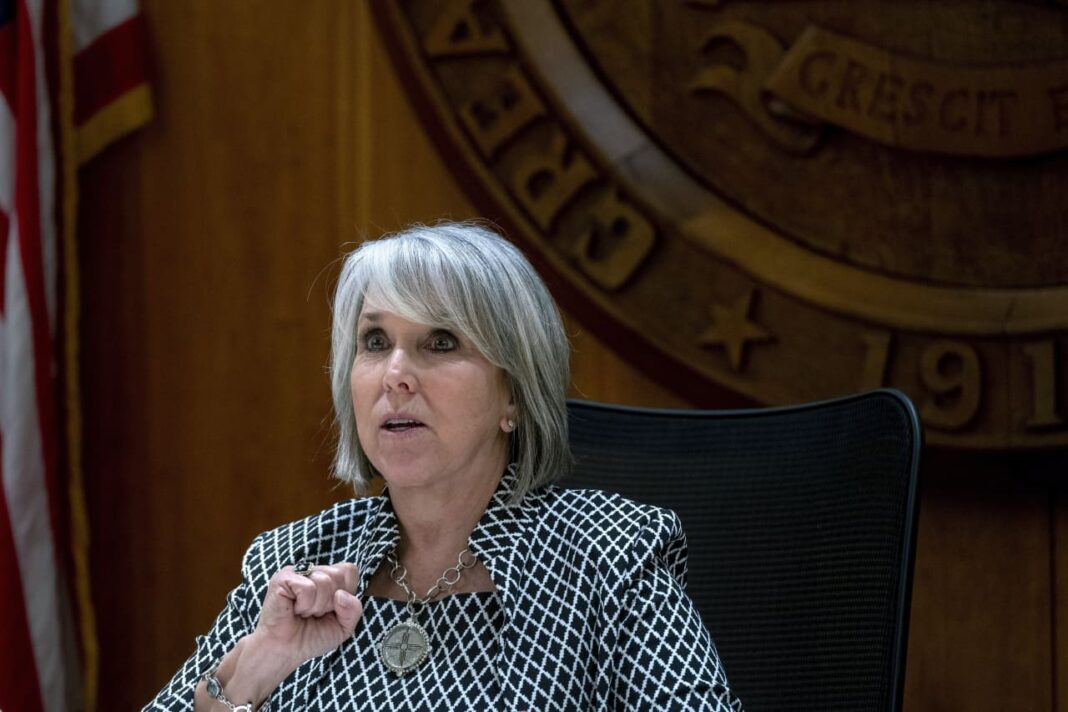What good are electric vehicles in a sparsely populated state with a high poverty rate?
New Mexico isn’t California. The landlocked state’s population is tiny by comparison and has the nation’s highest poverty rate, according to the Census Bureau. Yet New Mexico’s ruling progressives have embraced the same green-energy policies as their wealthy neighbors on the coast. This will be a disaster for New Mexicans.
In 2019 newly inaugurated Gov. Michelle Lujan Grisham signed the Energy Transition Act, which requires that half the state’s electricity come from wind and solar sources by 2030. That requirement rises to 100% by 2045. In October 2023, Ms. Grisham, a Democrat, signed an executive order requiring that all state vehicles be electric by 2035. Notably, firetrucks, police cars, snowplows and other emergency vehicles are exempt.
In November 2023, the state’s unelected Environmental Improvement Board adopted California’s Advanced Clean Car II rule, requiring increasing percentages of New Mexico’s new car and light-truck sales to be electric: beginning with 43% in the 2027 model year, increasing to 82% for 2032 vehicles, and rising to 100% in 2035.
Most recently, in March 2024, Ms. Grisham signed legislation adopting California’s Clean Fuels rule, which requires reductions in the “carbon intensity”—the amount of carbon dioxide released when burned—of fossil fuels sold in the state. But the actual amount of CO2 in fossil fuels can’t change. To account for this, the rule establishes a system of tradeable credits that fuel-sellers—refineries, electric and gas utilities and propane distributors—can purchase from zero-emissions sources such as biofuel manufacturers. As in California, oil refineries in New Mexico will likely either shut down or convert to manufacturing biofuels, further raising gasoline and diesel prices.
While New Mexico contributes very little to total global greenhouse-gas emissions, half of what the state does emit is associated with oil and gas production, which in 2023 contributed about $4 billion in revenue to state coffers—40% of total state government spending. Progressives in the state who want to shut down the industry, starting with legislation to restrict drilling and production, are really looking to impoverish New Mexicans.
Electricity rates will soar, as they have in California, as utilities attempt to meet the zero-emissions mandate. In June, PNM, the state’s largest electric utility, proposed to raise customer rates by as much as 27%, on top of a rate increase that took effect earlier this year.
An all-electric-vehicle future for the state is unrealistic. EVs accounted for slightly over 4% of new vehicles sold in New Mexico at the end of 2023. Only 10,000 EVs were registered in the state—0.5% of the two million registered vehicles in New Mexico. Although EVs might be a fine choice for wealthy city dwellers who don’t need them for long trips, consumers and businesses in the remainder of the state aren’t buying EVs.
Travis Hicks, managing partner for several dealerships in Roswell, says he sells about one EV every six months. The majority of his sales are pickups for the ranchers and oil-field workers who drive the economy in the state’s southeast, which overlaps with the oil- and gas-rich Permian Basin. Most of his customers travel long distances daily and haul heavy loads, which EVs aren’t designed for. “Dealers like me will be forced to buy EVs I can’t sell,” he says, “and I won’t be able to sell the vehicles my customers want to buy. No business can survive that.”
The extremes of weather in the state—winter temperatures in the northern mountains can reach minus 30 degrees and summers in southern areas can top out at 110 degrees—are also EV-unfriendly, sapping battery range. Albuquerque and Santa Fe, where virtually all EVs are sold, have charging stations, as do some of the state’s interstate highways and major roads. Elsewhere in New Mexico, charging stations are rare. On the back roads they’re nonexistent. To build charging infrastructure across the state would cost billions of dollars and send electricity rates even higher.
Proponents of the Clean Fuels rule claim it won’t raise energy prices. The economic reality is different. Renewables are more expensive to produce than fossil fuels. Forcing refiners, distributors and utilities to purchase credits to offset carbon emissions from oil and gas will necessarily raise prices. Gasoline, diesel, natural gas and propane prices will increase as sellers meet the clean fuel standards, raising prices for virtually all goods and services sold.
Adopting California’s green-energy policies may make New Mexico progressives feel virtuous. But these policies will drive the poverty rate even higher. There’s no virtue in that.
Mr. Lesser is a senior fellow with the National Center for Energy Analytics and a senior fellow with the Discovery Institute.







